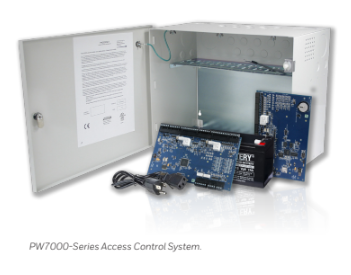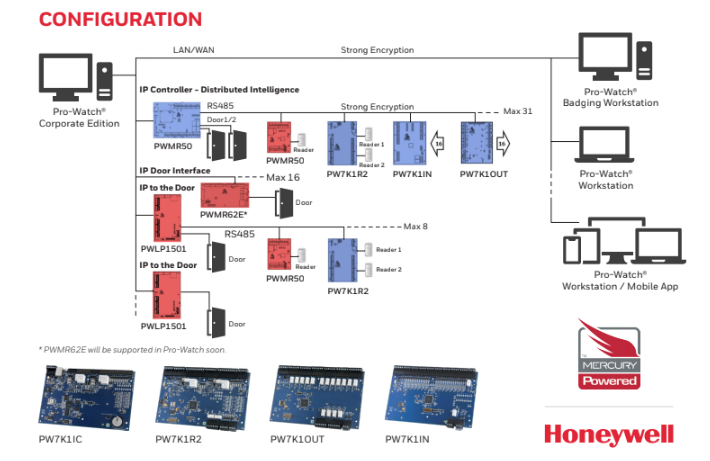CARD ACCESS SYSTEM

PW7000-SERIES
PRODUCT DESCRIPTION
The PW7000-Series Access Control System is an advanced access control hardware architecture capable of providing solutions for large enterprise applications
The Intelligent Controllers provide power and flexibility with an embedded Linux OS, improved processor and increased memory as well as onboard crypto chip which adds an additional layer of security to sensitive data.
The PW-series controllers support a combination of I/O and reader boards to monitor alarm input points, relay output points and interface with access control readers. By offering a modular design, the system can be tailored to meet a wide range of applications while optimizing cost and installation


The PW7000-Series Access Control System is an advanced access control hardware architecture capable of providing solutions for large enterprise applications.
The Intelligent Controllers provide power and flexibility with an embedded Linux OS, improved processor, and increased memory, as well as an onboard crypto chip that adds an additional layer of security to sensitive data. The PW-series controllers support a combination of I/O and reader boards to monitor alarm input points, relay output points, and interface with access control readers. By offering a modular design, the system can be tailored to meet a wide range of applications while optimizing cost and installation. The PW7K1IC comes with 2 on-board reader ports that support multiple reader communication protocols including Wiegand and OSDP (V2) Secure Channel Protocol (SCP). OSDP SCP is now supported across all the intelligent controller and reader board hardware. PW7000-series control panels and I/O boards are backwards compatible with PW6000-Series*.
FEATURES AND BENEFITS
ECURE
- Latest encryption standard support with TLS1.2 and OSDP (V2) Secure Channel Protocol
- Embedded Crypto Memory Chip to protect sensitive data
VERSATILE
- Backwards compatible with PW6000* controllers, reader boards, I/O boards, and enclosures*
- On-board support for up to 2 readers (2 Doors) for PW7K1IC and up to 2 readers (1 Door) for PWLP1501
COMPREHENSIVE
- Wide variety of native integrations including wireless locks
- Extensive customization including If / Then macro capabilities
ADAPTABLE
- Modular design allows controllers and downstream boards to be mixed to fit the most demanding customer requirements
- Flexible power options for PWLP1501 and PWMR62E including PoE and PoE+
specifications
CONFIGURATION

FUNCTIONAL DESCRIPTION
The multi-port PW7K1IC is a dual card reader panel for controlling two connected doors and managing up to 64 doors/openings. Built with Authentic Mercury Technology (LP1502), the intelligent controller uses an on-board Ethernet port to connect to the Honeywell server-based platform ‘Pro-Watch’.
The intelligent controller performs access control, alarm management, and scheduled operations, all in a single package. With native connectivity, the high-performance PW7K1IC functions independently of the host for performing numerous access control applications and supports OSDP, OSDP Secure Channel, keypads, biometric readers, Wiegand, clock and data, F/2F, and supervised F/2F reader technologies.
System configuration and setup are provided through Mercury software applications/tools. For a comprehensive and open Honeywell access control platform, and a reliable hardware platform running in a secure environment, the PW7K1IC is the clear solution. It delivers a complete security and access control solution as well as innovative application extensions, interoperability, and data security.
* Note: Full native PW7000 mode (On-board Reader/Door support on IC
board; OSDP (V2) Secure Channel; OSDP 4 readers; OSDP Push
FW) Coming soon in Pro-Watch.
ORDERING
Request a Quote
Learn More From
Frequently Asked Questions
Multimode fiber commonly comes in 50/125 μm or 62.5/125 μm core/cladding dimensions, with bandwidth capacities ranging from 200 MHz to 2 GHz, depending on the grade. Multimode systems typically support transmission distances of up to 5 km, making them suitable for short- to medium-range applications.
In contrast, singlemode fiber—usually 9–10/125 μm—offers significantly lower attenuation and effectively unlimited bandwidth, supporting links over 150 to 200 km, especially when paired with optical amplifiers and advanced transceivers.
While singlemode fiber is less expensive per meter, its associated transceivers and equipment tend to cost more than their multimode counterparts. That said, singlemode devices are generally compatible with both singlemode and multimode fiber, whereas multimode equipment works only with multimode fiber.
Let me know if you’d like this turned into a quick-reference table or visual comparison—it’d make a solid inclusion for a fiber deployment guide.
The link budget is the difference between the transmitter’s output power and the receiver’s sensitivity. This budget must account for all signal losses along the path, including:
- Fiber attenuation due to the transmission medium
- Connector losses, such as those at patch panels or equipment interfaces
- Splice losses from mechanical or fusion joints
- Link margin, which provides a buffer for unforeseen variations
The link margin typically ranges from 2–3 dB in tightly controlled environments to up to 10 dB in more variable conditions. It is designed to accommodate:
- Component aging (e.g., light sources may degrade and lose up to 3 dB over time)
- Temperature variations affecting transmitter output or receiver sensitivity (up to 3 dB may be needed for thermal fluctuations)
- Physical cable damage and repair-induced losses (usually minor, but more relevant in harsh or industrial settings)
Always design your system for worst-case scenarios to ensure reliability. However, don’t overlook the best-case condition either—some optical receivers may exhibit erratic behavior if the incoming signal is too strong.
First, verify the optical signal strength along the link. Use an optical power meter to measure the received power at the fiber’s end point. Typical transmit levels range from –8 dBm to –15 dBm, while the receiver sensitivity is around –31 dBm, giving you a link budget of approximately 16 dB. This margin supports transmission distances of up to 10 km on singlemode fiber and about 3–5 km on multimode fiber.
If the measured power falls below the receiver sensitivity, there’s a strong likelihood of issues with the installed fiber. Ideally, initial OTDR readings should have flagged such faults.
If not, inspect the patch cords currently in use for possible defects or misalignment. A frequent oversight is the use of mismatched patch cords.
Multimode fiber types are classified by the ISO/IEC 11801 standard into five main categories: OM1, OM2, OM3, OM4, and OM5. Each type differs in core size, bandwidth, supported data rates, and maximum transmission distances. Here’s a quick breakdown:

- OM3 and OM4 are laser-optimized and widely used in modern data centers.
- OM5 supports shortwave wavelength division multiplexing (SWDM), enabling multiple wavelengths over a single fiber for higher capacity.
- All OM types are backward compatible in terms of connectors, but mixing core sizes (e.g., OM1 with OM3) can cause performance issues.
